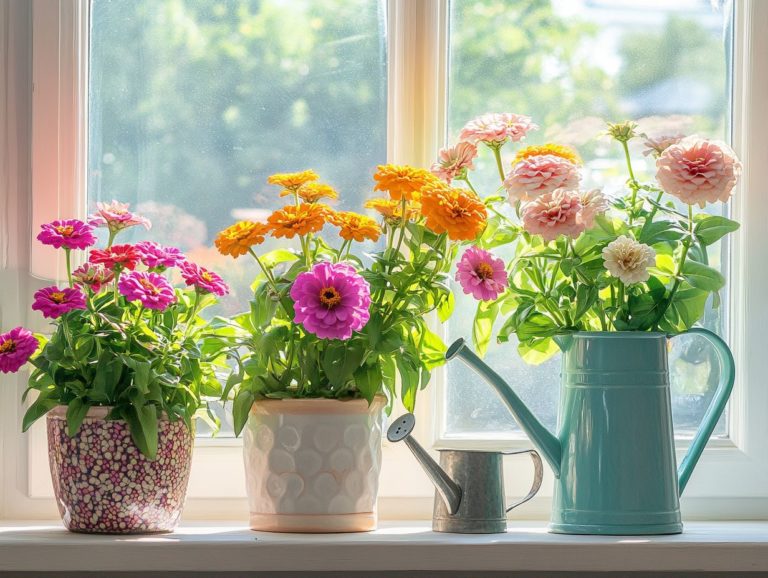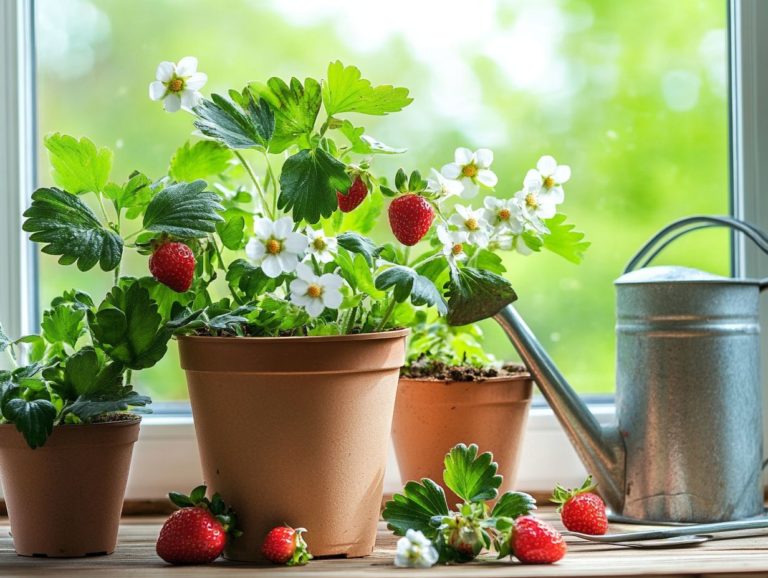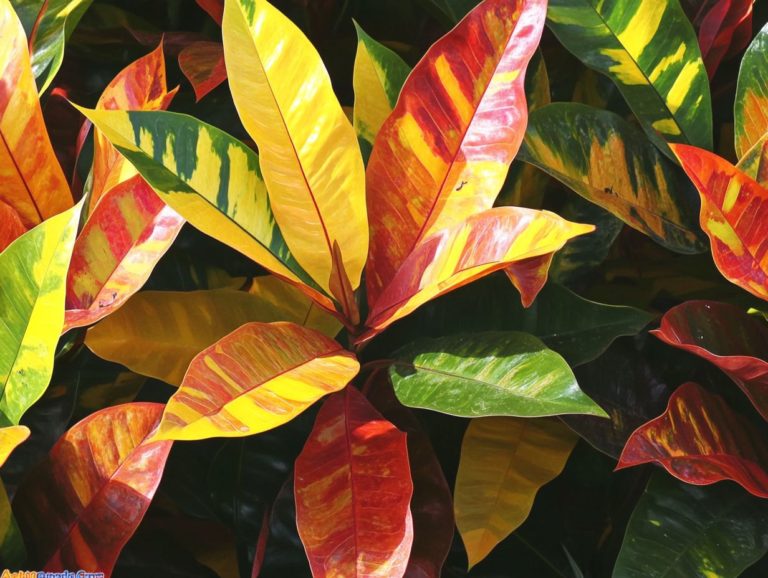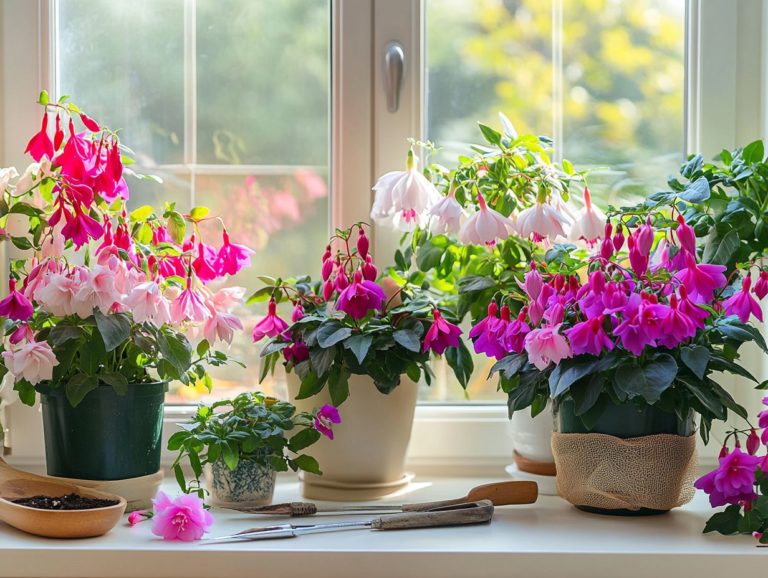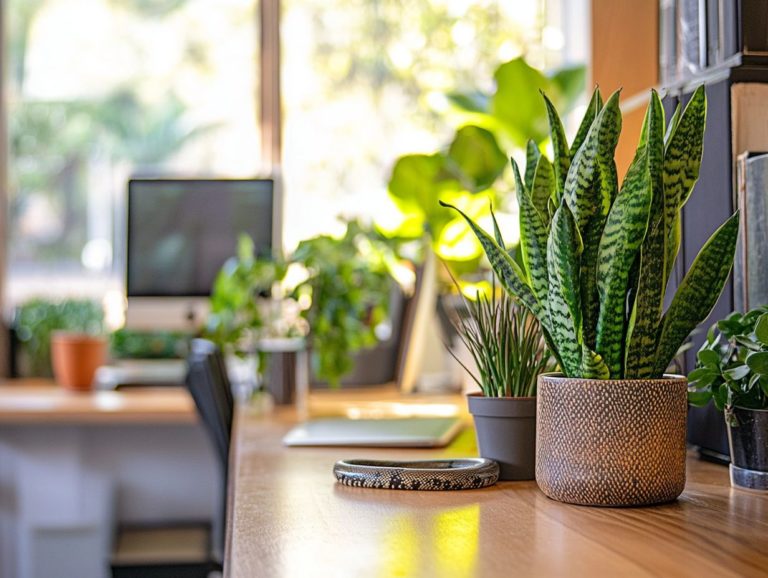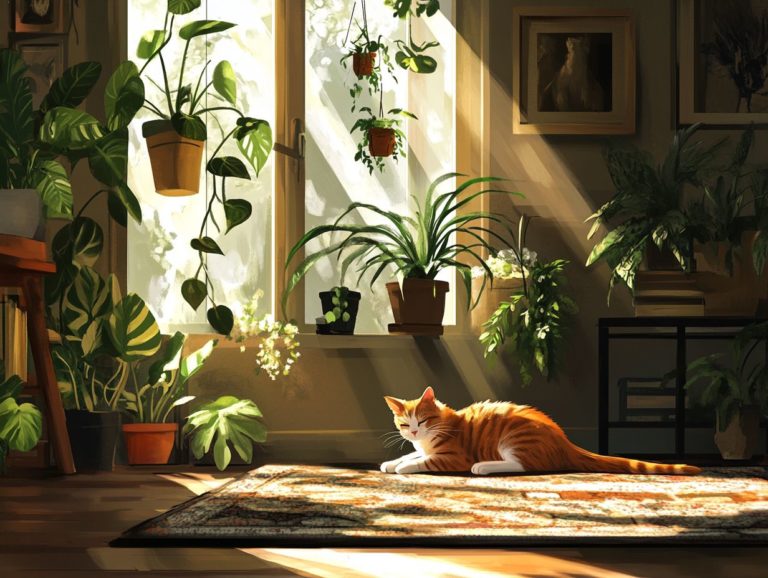Top 5 Indoor Plants for Humid Spaces
Transforming your home into a lush, green oasis can be an incredibly rewarding experience, especially in those humid spaces where moisture reigns supreme.
Indoor plants don t just add a touch of elegance to your decor; they do well in the moisture-rich environments of kitchens, bathrooms, and sunrooms. These best bathroom plants can transform your space into a lush paradise.
Consider exploring the top five indoor plants, such as the Peace Lily and Boston Fern, designed to flourish in high humidity and create a spa-like experience.
You ll uncover their myriad benefits, ideal growing conditions, and maintenance tips. Discover how these plants can elevate your home s aesthetic and improve your air quality!
Ready to transform your space with nature’s beauty?
Contents
Key Takeaways:
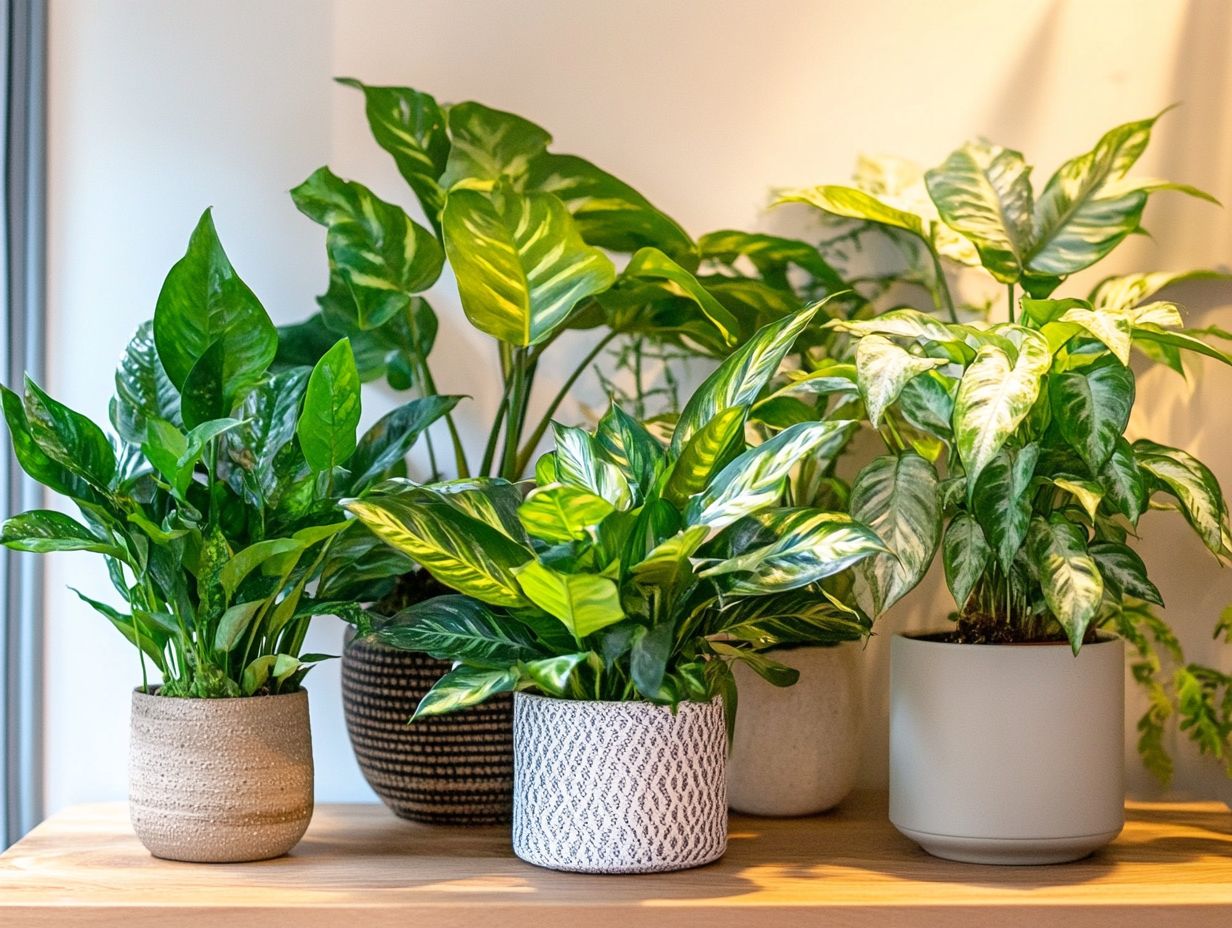
- Indoor plants in humid spaces improve air quality and provide numerous health benefits.
- These plants do well in humid conditions and require minimal maintenance.
- The top 5 indoor plants for humid spaces are Peace Lily, Boston Fern, Spider Plant, Chinese Evergreen, Heartleaf Philodendron, and Calathea Freddie.
1. Peace Lily
The Peace Lily is more than just a gorgeous indoor plant; it s renowned for its striking white blooms and its ability to thrive in high humidity. This makes it an exceptional choice for you if you’re looking to create a serene atmosphere in spaces like bathrooms or other humid areas, contributing to a calming environment.
This adaptable plant is impressively hardy. It flourishes in low light and requires minimal maintenance, making it ideal whether you re a novice or a seasoned plant enthusiast.
With optimal humidity levels between 40% and 60%, it can effectively combat dryness in the air, helping to reduce humidity.
Its air-purifying qualities are impressive. The Peace Lily and other moisture-absorbing plants filter out common toxins, including formaldehyde and benzene. By welcoming this elegant plant into your indoor environment, you can effortlessly elevate air quality and foster a sense of tranquility.
2. Boston Fern
The Boston Fern stands out as a popular tropical plant, celebrated for its lush, vibrant foliage. It thrives in the humidity of bathrooms, adding a spa-like ambiance with its rich greenery.
To ensure this fern flourishes, it craves indirect light, making it the perfect choice for spaces near east or north-facing windows.
You ll want to keep the air around the plant moist, so monitoring humidity levels is essential, especially during dry seasons. Regular misting or employing a pebble tray filled with water can significantly enhance its environment.
Watering should be done when the top inch of soil feels dry, which typically means once a week, though this can vary depending on your climate.
Occasionally trimming yellow or dead fronds will promote healthy growth and maintain its elegant shape, allowing the Boston Fern to continue being a stunning centerpiece in any room.
3. Spider Plant
The Spider Plant stands out as an exceptional indoor choice, celebrated for its hardiness and ability to thrive in a variety of conditions. This makes it an ideal companion for bathrooms, where humidity levels can fluctuate.
Not only does this remarkable plant thrive in moist environments, but it also plays a crucial role in purifying your air, effectively absorbing harmful pollutants and releasing fresh oxygen.
To keep your Spider Plant in peak condition, remember to provide it with indirect sunlight and maintain slightly damp soil these simple care tips go a long way.
Its adaptability allows it to flourish even in low-light situations, making it a perfect fit for those darker corners of your home.
With its lush green foliage and charming arching leaves, the Spider Plant effortlessly enhances any indoor space, bringing a refreshing touch of nature to your modern decor.
4. Chinese Evergreen
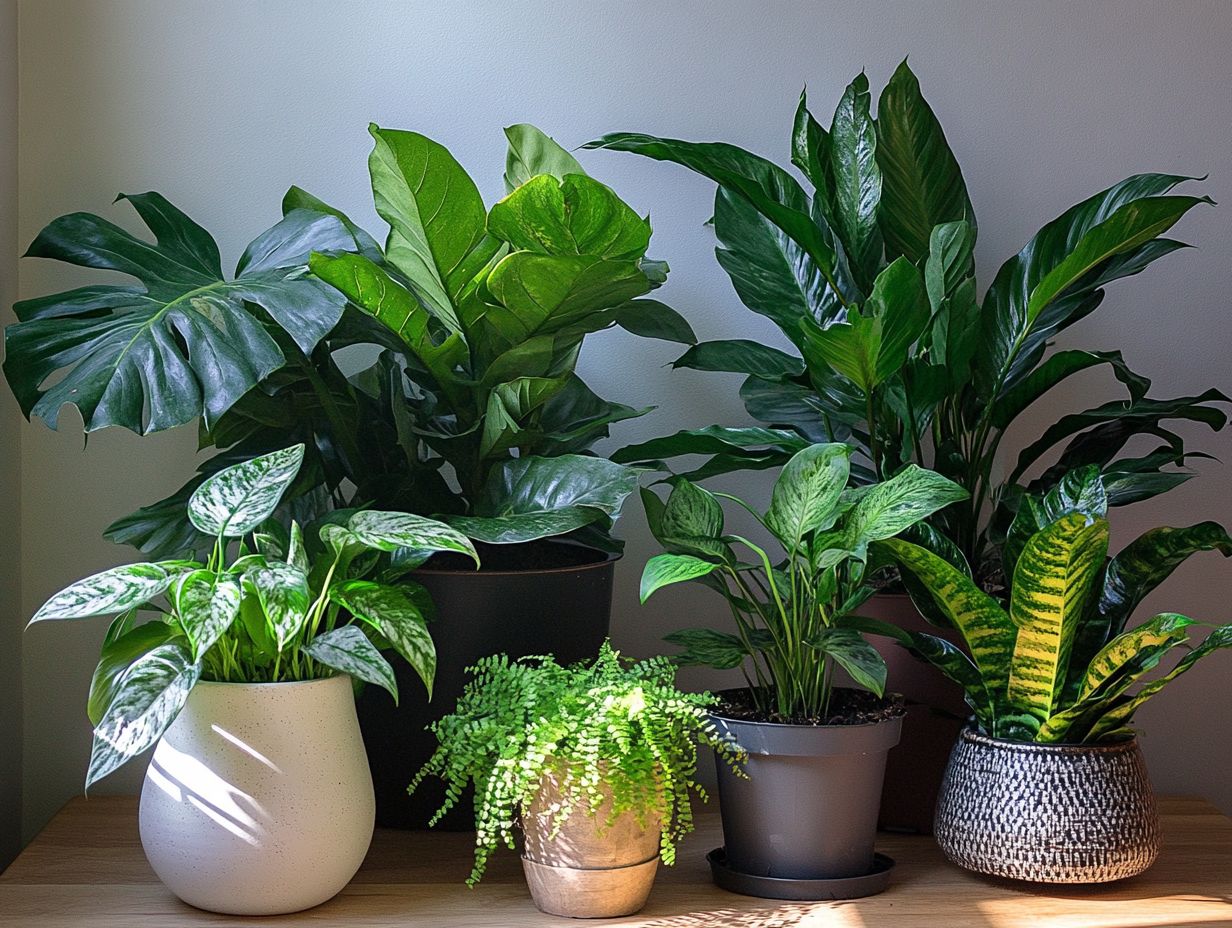
The Chinese Evergreen is your go-to plant that loves humidity! Known for its striking leaves and ease of care, it s a favorite for indoor spaces, especially bathrooms where humidity levels reign supreme. It s a great addition to any collection of indoor humidity-loving plants.
You can choose from a variety of stunning types, such as the Aglaonema ‘Silver Queen’, boasting silvery-green leaves that effortlessly elevate any room, and the vibrant ‘Red Romance’ with its eye-catching crimson accents. Each plant offers a unique flair to your decor, making them essential for creating a spa-like experience!
While these plants thrive in bright, indirect light, they re also adaptable enough to handle low-light conditions. They are incredibly forgiving! Just remember to water when the top inch of soil feels dry to help your plant avoid root rot, a condition that can harm plants if they are overwatered.
Beyond their visual charm, Chinese Evergreens are celebrated for their ability to clean the air. They filter out harmful toxins, enhancing your overall well-being.
5. Philodendron
The Heartleaf Philodendron, with its delightful trailing vines and heart-shaped leaves, is a beloved indoor plant that brings joy to your space! This plant flourishes in humid environments, making it an exceptional addition to bathrooms that crave a hint of greenery.
This low-maintenance beauty thrives best in indirect sunlight. Direct rays can risk scorching those lovely leaves. In terms of watering, it’s vital to let the top inch of soil dry out between watering sessions, ensuring the roots stay healthy and robust.
With its lush foliage cascading gracefully, this plant can be elegantly displayed in hanging planters or as part of shelf arrangements. It infuses living rooms, kitchens, or any indoor space with a fresh and vibrant aesthetic. For those looking to enhance their indoor gardens, exploring the top 5 tropical plants for indoor environments is a great option. Its versatility and minimal care requirements make it an ideal choice for both novice plant owners and seasoned green thumbs alike!
What Are the Benefits of Having Indoor Plants in Humid Spaces?
Having indoor plants in humid spaces brings a host of benefits that elevate both your environment and well-being. They enhance air quality while adding a touch of elegance, creating a calming atmosphere that contributes to your overall comfort.
These plants naturally dehumidify the air, helping to prevent mold growth and making your space feel more inviting. Increased humidity levels support respiratory health and keep your skin hydrated, adding to the overall allure of your surroundings! For those with northern windows, consider the top 5 plants that thrive in such conditions.
Consider species like the peace lily and snake plant; they thrive in moist conditions while effectively filtering out toxins. Surrounding yourself with greenery can also yield psychological benefits. Studies indicate that having plants around can reduce stress and anxiety, fostering a profound sense of serenity and a deeper connection to nature.
What Are the Ideal Growing Conditions for These Plants?
The ideal growing conditions for humidity-loving plants often include warm temperatures, indirect light, and consistently high humidity levels. This makes them exceptionally suited for bathroom spaces and ideal for plants like the Chinese money plant and Asparagus fern.
To truly thrive, these plants typically prefer temperatures that feel comfortable for you, ranging from 65 F to 80 F. Extreme temperatures can disrupt their growth. Monitor your watering frequency carefully, generally aiming for every 1-2 weeks. Allow the top inch of soil to dry out between waterings! This delicate balance prevents root rot while ensuring adequate moisture.
Proper light conditions, usually bright, indirect sunlight, are essential. Direct exposure can scorch those delicate leaves. By creating a suitable environment, you enable vibrant foliage and overall health, allowing these plants to flourish beautifully in their chosen spaces.
Embrace the beauty of indoor plants today and breathe easier in your home!
How Can These Plants Improve Air Quality?

Indoor plants that love humidity not only elevate the aesthetic of your space but also play a crucial role in enhancing air quality by filtering toxins and releasing oxygen. Imagine your home filled with fresh air!
These remarkable plants achieve this through various ways, absorbing harmful substances like formaldehyde, benzene, and carbon monoxide. Take, for instance, the Peace Lily; it’s renowned for its ability to remove these pollutants from the air. This effectiveness is backed by studies conducted by NASA that underscore its performance in closed environments.
Similarly, the Spider Plant shines in its capacity to reduce indoor ozone concentrations. This emphasizes the significance of welcoming green companions into your living spaces. By choosing the right plants, such as those in the top 5 indoor plants that bloom, you can enrich both the aesthetic appeal and overall health of your environment, providing a natural remedy for indoor air pollution.
What Are the Maintenance Requirements for These Plants?
Maintaining humidity-loving indoor plants requires a thoughtful approach, including regular watering, the right light exposure, and careful monitoring of humidity levels to ensure their vibrant health and longevity.
These plants thrive with consistent watering schedules. Check the soil moisture every few days, adjusting your routine based on the season and your indoor climate. Fertilizing your plants is important too; using a balanced liquid fertilizer every four to six weeks during the growing season can deliver the crucial nutrients they need to flourish.
Don’t wait! Regularly inspect for pests like spider mites or aphids. Treating them promptly with organic solutions will keep your plants thriving. A hygrometer, a device that measures humidity, helps you monitor humidity levels effectively, as many of these plants prefer environments with 40-60% humidity. If you’re looking for the best options, check out the top 5 indoor plants for small apartments.
To achieve this, consider placing a humidifier nearby or using pebble trays filled with water. This will effectively raise humidity and create a spa-like experience for your plant life to thrive, including top 5 shade-tolerant indoor plants.
What Are Some Tips for Choosing the Right Indoor Plants for Humid Spaces?
When you re selecting indoor plants for humid spaces, it s essential to consider their specific humidity needs, light preferences, and overall care requirements to cultivate a thriving indoor garden.
The size of your area plays a significant role; larger spaces can accommodate taller or wider plants, while compact areas often benefit from smaller varieties or climbing options that make the most of vertical space. For those looking to enhance their indoor environment, exploring the top 5 indoor plants for seasonal changes can provide great options. Adequate lighting is another crucial factor; some plants flourish in bright indirect light, while others thrive in low-light conditions that might otherwise seem uninviting.
Your personal aesthetic choices will also guide your plant selection, whether you lean towards lush, leafy greens like Bamboo or vibrant flowering species such as Flamingo flower that catch the eye.
For humid environments, choose plants like the Peace Lily, Boston Fern, or Spider Plant for your home. These plants not only thrive in moist conditions but also infuse your space with character and life.
Can These Plants Be Used for Decoration as Well?
Indoor plants, particularly those that thrive in humidity, can elevate your space into a stunning sanctuary, creating a tranquil atmosphere and enhancing the overall aesthetic. Plants like Calathea Freddie and Air plants are perfect examples.
Envision vibrant plants like pothos and philodendron transforming your home! Place them in strategic spots to create focal points that draw the eye and spark delightful conversations. Picture a lush monstera soaking up the sun in a bright corner, infusing your home with a tropical vibe. For those interested in optimizing their indoor garden, consider the top indoor plants for varied lighting. Smaller plants like ferns can find their perfect homes on floating shelves or window sills, harmonizing beautifully with decor elements like books or candles.
Consider grouping your plants to play with varying heights and textures. A tall snake plant alongside cozy, textured pillows on your sofa can cultivate an inviting atmosphere that complements both modern and bohemian styles. Layer these greens with natural materials, such as a wooden coffee table or wicker baskets, and watch as the organic feel of the room flourishes.
Frequently Asked Questions

What are the top 5 indoor plants for humid spaces?
The top 5 indoor plants for humid spaces are Peace Lily, Pothos, Spider Plant, Philodendron, and Chinese Money Plant.
Why are these plants suitable for humid spaces?
These plants thrive in high humidity, making them perfect for humid spaces like bathrooms.
What benefits do these plants offer for indoor spaces?
These plants improve air quality, reduce stress, and add a touch of greenery to your home or workplace.
Are these plants low maintenance?
Yes, these plants are generally low maintenance and do not require much attention or care. Proper watering and lighting are essential for their growth and health.
Can these plants be grown in other environments?
Yes, these plants can also thrive in other environments but may require more attention and care to adapt to different humidity levels, especially when considering plant care tips.
Where can I purchase these top 5 indoor plants for humid spaces?
You can purchase these plants at your local plant nursery, home improvement stores, or online from reputable sellers. Make sure to research the specific needs of each plant before purchasing.

